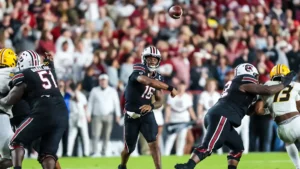
Tennessee Volunteers Safety John Slaughter Enters Transfer Portal, Seeks Fresh Start
John Slaughter, a promising young safety for the Tennessee Volunteers, officially entered the NCAA transfer portal this week, signaling a significant development in both his career and the depth chart for the Vols’ secondary. While not necessarily a headline name during his time in Knoxville, Slaughter had steadily gained attention from fans and coaches for his physical play, intelligence on the field, and long-term potential. His decision to explore opportunities elsewhere adds to a growing list of players navigating the increasingly fluid landscape of college football, shaped by the transfer portal and evolving roster dynamics.
A native of Southaven, Mississippi, Slaughter was a three-star recruit coming out of high school and committed to Tennessee as part of the 2023 class. The 6-foot, 200-pound safety chose the Vols over offers from Ole Miss, Mississippi State, Louisville, and others, drawn to the program’s rising trajectory under head coach Josh Heupel and defensive coordinator Tim Banks. His recruitment reflected Tennessee’s continued focus on building defensive depth, especially in the secondary where versatility and physicality are critical components of the scheme.
Slaughter arrived at Tennessee with a reputation for delivering bone-jarring hits and an aggressive approach to run support, but also brought a high football IQ and underrated coverage skills. He quickly acclimated to the speed of the college game, using his instincts and tenacity to impress during practices. Although he did not see extensive action during his freshman season, Slaughter was viewed internally as a developmental piece with a potentially bright future. His contributions on special teams and in select defensive packages hinted at a player on the rise.
However, as is often the case in today’s college football world, the depth chart is in constant flux. The Volunteers have recruited heavily at the safety position over the past two cycles, adding both high school talent and experienced transfers to create competition. With players like Andre Turrentine, Jourdan Thomas, and Christian Charles competing for time, the battle for snaps in the defensive backfield has become more intense. The emergence of young stars and incoming freshmen likely influenced Slaughter’s decision to consider a move elsewhere—one where he could compete for a larger role immediately.
It’s also worth noting the personal and psychological dimensions that accompany such a decision. For many young players, entering the transfer portal is not simply a football decision—it reflects a broader desire for growth, opportunity, and the right environment. Whether it’s a matter of finding the best coaching fit, a scheme that better suits a player’s strengths, or simply a place where he can see the field more consistently, these decisions are rarely made lightly. Slaughter’s move suggests a calculated, mature approach to his career trajectory, acknowledging that development sometimes requires a change in scenery.
Tennessee fans may feel a mix of disappointment and understanding in response to Slaughter’s departure. On one hand, it’s never easy to see a promising player leave, particularly one who bought into the program early and showed signs of becoming a contributor. On the other, this is the new normal in college football. The portal giveth and it taketh away. Just as the Vols have lost Slaughter, they’ve gained other key contributors in recent years who chose Knoxville as a fresh start after leaving other programs. This reality requires adaptability from coaching staffs and fans alike.
Slaughter’s departure also raises questions about depth in Tennessee’s secondary heading into the 2025 season. While the Vols appear relatively well-stocked at safety, injuries and unexpected developments can test a unit’s resilience. Losing a player with Slaughter’s upside—even if he wasn’t yet a starter—reduces the margin for error and could force younger or less experienced players into bigger roles earlier than expected. It may also re-shape Tennessee’s transfer strategy as the portal window remains open and new targets emerge.
There’s no official word yet on where Slaughter may land, though speculation will likely heat up in the coming days. Programs across the country in need of a tough, intelligent safety with two or more years of eligibility will surely take notice. Slaughter’s SEC experience, physical tools, and reputation as a hard worker make him an appealing addition for defensive coordinators looking to bolster their units. A return closer to home in Mississippi isn’t out of the question, nor is a move to a mid-major program where he could step into a leading role immediately.
For Slaughter, the transfer marks the beginning of a new chapter rather than the end of anything. His time at Tennessee, while perhaps not as headline-grabbing as others in his class, helped shape his foundation as a college athlete. He leaves having learned the demands of high-level football, developed under strong coaching, and tested himself against elite competition. Those experiences will serve him well wherever he goes next. In many ways, his story is emblematic of a broader shift in college sports—where player movement is more accepted, and the ability to pivot is seen as a strength rather than a disruption.
Tennessee, meanwhile, will continue to forge ahead with a defense that has steadily improved under Tim Banks’ leadership. The Vols’ 2024 campaign showed encouraging signs on that side of the ball, and they will aim to build on that momentum with a retooled secondary. Slaughter’s departure opens the door for someone else to step up, just as his own arrival once did. Competition breeds excellence, and the culture Heupel is cultivating in Knoxville thrives on depth, development, and accountability.
Ultimately, Slaughter’s exit should be viewed not as a loss, but as a transition. It’s a reminder of how dynamic today’s college football environment truly is—and how players and programs must constantly evolve to meet new challenges. Fans of the sport have grown more accustomed to these mid-career moves, and while they can sting in the short term, they often lead to positive outcomes for all involved. If Slaughter finds a home where his skill set can shine and he’s given the opportunity to play the game the way he knows how, both he and his next team will benefit.
There’s also the human aspect to remember. These are young men navigating not only their athletic journeys, but also personal growth and academic aspirations. The decision to transfer often comes with emotional weight—leaving behind teammates, coaches, and fans who supported them. But it also represents courage, belief in one’s potential, and a willingness to take risks in pursuit of a dream. Slaughter’s move should be respected in that light.
Looking ahead, Tennessee remains well-positioned to continue developing talent and competing in the SEC. The defensive backfield, while impacted by Slaughter’s departure, still features a strong mix of veterans and rising players. Whether through continued internal development or another addition via the portal, the Vols will adjust. For Heupel’s staff, maintaining relationships and recruiting the right cultural fits becomes even more important in a time when roster continuity is increasingly rare.
For John Slaughter, the next few weeks could be career-defining. He’ll be looking for a coaching staff that believes in his game, a locker room that feels like home, and a defensive scheme where his abilities—particularly as a downhill enforcer—can be fully realized. If those stars align, there’s every reason to believe Slaughter can blossom into a high-impact defender and leader. The tools are there, and now he just needs the right stage.
In the end, the transfer portal is a tool for mobility and second chances. John Slaughter is taking his shot, betting on himself, and chasing the kind of opportunity that every college athlete dreams of: to compete, to grow, and to leave a legacy. Time will tell where he lands and how his story unfolds, but for now, his decision marks an important moment in his journey—and another example of how college football’s future continues to be shaped by players who aren’t afraid to take control of their path.





